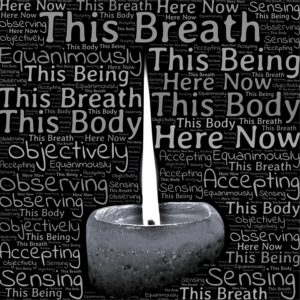1. Breathing. Practicing Buddhism in everyday life is very specific. Words are necessary to give suggestions for practice in everyday life. The fewer, the simpler, and the more specific they are the better.
Almost all successful Buddhist practices do 2 things. They bring the person’s attention to the present moment. They help to “he here now.” The 2nd is that they tend to disrupt conceptual thinking. They also move the person toward a calm, nonconceptual, blissful state of mind.
Fitzgerald’s 10th verse in his Rubiyaat offers one means toward this Buddhist goal. “Ah, beloved, fill the Cup that clears Today of past regrets and future fears.” Not only Buddhists take this route. Alcoholic beverages do clear regrets and fears. Tranquilizers also work. Both work at a cost. Impairment functioning accompanies all chemical means toward nonconceptual.
Stopping the internal dialogue or monologue, reaching inner silence and peace, is possible without resorting to chemicals. It takes a lot of practice. Formal practice helps. Practice during activities of everyday life helps more. It is possible to be non-conceptual, to stop verbal thinking deliberately.
Attention to breathing is one such practice.
It can be done at any time, any place. Only one or two breaths or hundreds or thousands can be noted, perhaps counted. Making it healthy breathing as well is an even better practice. What is healthy breathing?
Healthy breathing completely empties the lungs with each breath.
It gets as much of the poisons and wastes out as possible. Practically no one breaths healthily all the time. Emphasizing exhaling often and repeatedly is good practice. It can gradually move habitual unhealthy breathing toward habitual healthy breathing. Smiling and being amused at repeated failure to stay with it is also a good practice.
 Breathing awareness can only occur now, since our breath is moving, changing pausing all the time. It helps us “be here now.” Anyone can try to follow the advice implicit in “The perfected yogi is aware of every breath.”
Breathing awareness can only occur now, since our breath is moving, changing pausing all the time. It helps us “be here now.” Anyone can try to follow the advice implicit in “The perfected yogi is aware of every breath.”
Attention, awareness can encompass only a limited number of things at any given moment. Some people can handle more, some less. Psychologists of William James time, around 1900, played with how many activities they could successfully manage at the same time. Singing a song, writing a letter, balancing a ball on a stick with the other hand, while tossing and catching a short piece of rope off one foot, all simultaneously is an example.
Staying aware of healthy breathing can accompany many of most peoples’ everyday activities. Staying aware of breathing while sweeping, hammering, sawing, cooking may be relatively simple. It is being aware of two things at once. Too the extent the mind is focused on both it is relatively silent, nonconceptual, not thinking. This article is now getting close to describing another practice. This other practice can be combined with an awareness of breathing. It can also be separated from breathing practice.
Ending without complicating how to practice awareness of breathing may be the better part of wisdom. Other articles under other headings can be used to present as simply and clearly as possible other Buddhist everyday practices.





